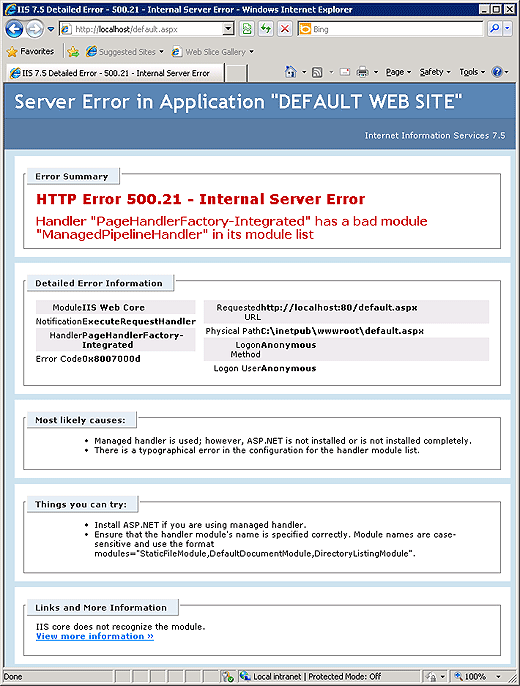Today I installed Clean Windows Web Server 2008 R2 64-bit with IIS 7.5. To my surprise opening .NET 4.0 application I received the following error:
IIS 7.5 Detailed Error - 500.21 - Internal Server Error
Server Error in Application "DEFAULT WEB SITE"
Internet Information Services 7.5
[Error Summary]
HTTP Error 500.21 - Internal Server Error
Handler "PageHandlerFactory-Integrated" has a bad module "ManagedPipelineHandler" in its module list
[Detailed Error Information]
Module IIS Web Core
Notification ExecuteRequestHandler
Handler PageHandlerFactory-Integrated
Error Code 0x8007000d
Requested URL http://localhost:80/default.aspx
Physical Path C:\inetpub\wwwroot\default.aspx
Logon Method Anonymous
Logon User Anonymous
[Most likely causes:]
•Managed handler is used; however, ASP.NET is not installed or is not installed completely.
•There is a typographical error in the configuration for the handler module list.
[Things you can try:]
•Install ASP.NET if you are using managed handler.
•Ensure that the handler module's name is specified correctly. Module names are case-sensitive and use the format modules="StaticFileModule, DefaultDocumentModule, DirectoryListingModule".
[Links and More Information]
IIS core does not recognize the module.
View more information »
As it turns out, some glitch caused this problem, and somehow .NET was not registered with IIS.
Running the following commands solved this issue:
%windir%\Microsoft.NET\Framework\v4.0.30319\aspnet_regiis.exe -i
%windir%\Microsoft.NET\Framework64\v4.0.30319\aspnet_regiis.exe -i
